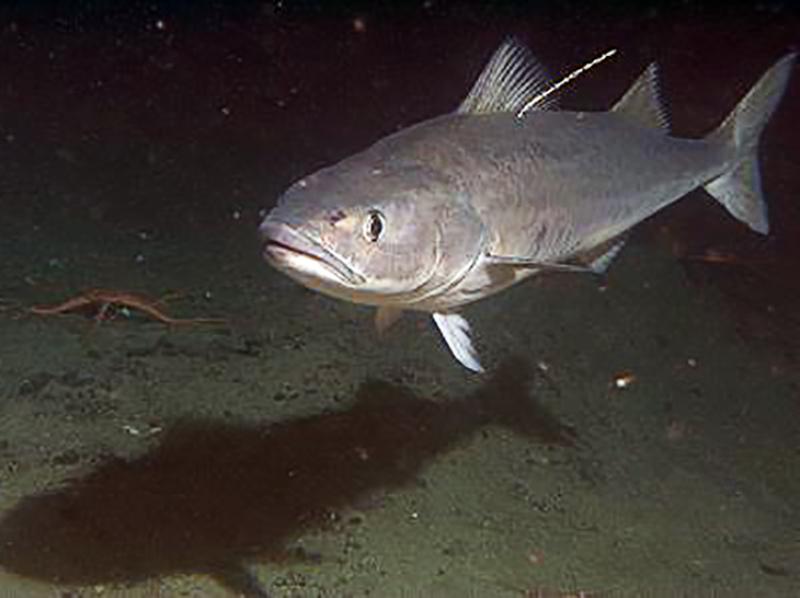Understanding the genetic structure of fish populations is vital to managing them sustainably into the future. Now cutting-edge genetic research confirms panmixia in North Pacific sablefish: They migrate and mix throughout their range to form a single genetic population.
The new study used whole genome sequencing to enhance understanding of sablefish population structure from Washington State to Alaska. Whole genome sequencing is one of the highest resolution genetic approaches available. It was the first genetic study to analyze juvenile sablefish, which should be more representative of spawning populations than the highly mobile adults. The research was a collaborative effort between:
- NOAA Fisheries
- University of Alaska Fairbanks
- University of Washington
- U.S. Fish and Wildlife Service
- Alaska Maritime National Wildlife Refuge
The findings will inform management strategies to ensure the long-term viability of this valuable commercial species.
“Sablefish are extremely important economically. They are super tasty, high value, and support a large commercial fishery,” said study co-lead Wes Larson, NOAA Fisheries Alaska Fisheries Science Center. “They are also an enigma: they live more than 1,000 feet deep, can move thousands of miles in their lifetime, and spawning fish have never been captured or observed. Improving our knowledge of their population structure improves stock assessment of these mysterious fish, and that improves sustainability.”
Panmixia in the North Pacific?
Understanding stock structure—how genetic variation is geographically distributed—is crucial for fisheries management. Genetic differentiation indicates demographic isolation and may indicate differences in adaptive traits among populations.
“The question is, is a segment of the population isolated? If you fish an isolated population and knock it down, it can be depleted. That segment of the population should be managed separately so it is not overfished,” Larson explained. “But if fish are moving around and mixing, the fish in a given area can be replenished over time. In that case the stock can be managed as a single population.”
Most previous genetic studies on sablefish have found panmixia throughout most of their range. However, a recent study suggested that there may be population structure.
Both findings were based on earlier, lower resolution genetic analyses using only adult sablefish.
“Answering this question was really important, so we wanted to look again using one of the highest resolution genetic approaches available,” Larson said.
Whole Genome Sequencing of Juveniles for a High Resolution Picture of Population Structure
Whole genome sequencing identifies millions of genetic markers compared with tens to thousands identified with earlier methods. This high-resolution analysis can detect subtle genetic structure that may indicate an isolated population.
The study conducted whole genome analysis on sablefish collected between 2006 and 2019.
To best represent population structure, the researchers sampled juvenile fish rather than only adults.
“Ideally you want to sample spawning populations. Adults may have moved thousands of miles from their spawning grounds. Small juveniles likely haven’t moved much yet. They are the closest we can get to the spawning population,” Larson explained.
Juvenile fish were collected from NOAA Fisheries Alaska Fisheries Science Center larval surveys. Others were collected from “beakloads” from bird surveys conducted by the U.S. Fish and Wildlife Service. Beakloads are food—in this case fish—that adult birds carry back in their beaks to their young.
“Beakloads are a neat way to use these birds as sampling vessels. We can sample fish from them before the birds are released,” Larson said.
Panmixia in the North Pacific
The study findings support the conclusion of genetic panmixia in sablefish throughout its northern range.
Data from 119 individuals screened for 7,110,228 genetic markers revealed no evidence of population structure. Reanalysis of the existing genomic dataset supported the same conclusion.
“This study confirms what was previously hypothesized because of tagging studies: that Alaska sablefish was one stock,” said Dana Hanselman, NOAA Fisheries Alaska Fisheries Science Center. “Sablefish are the only groundfish managed across the Gulf of Alaska and Bering Sea and Aleutian Islands Fishery Management Plans.”
“Our results also provide more evidence that these fish move incredibly far—potentially from San Diego to Alaska’s Aleutian Islands,” Larson said. “They are one of very few fish populations that appear to be truly panmictic.”
Larson said the best-known example of true panmixia is the American eel. These fish migrate and mix across the Atlantic Ocean to interbreed and form one population. “Sablefish are on that level.”
The research also demonstrates the capability of whole genome sequencing to investigate population structure in species with high migration rates.
“This is the beginning of many studies that will use this technique,” Larson said.







